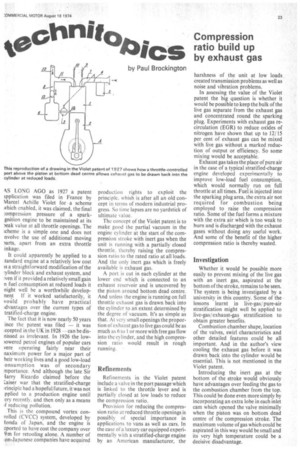Orin ita tiics by Paul Brockington AS LONG AGO as 1927
Page 25

If you've noticed an error in this article please click here to report it so we can fix it.
a patent ipplication was filed in France by Marcel Achille Violet for a scheme Nhich enabled, it was claimed, the final 3ompression pressure of a sparkgnition engine to be maintained at its 3eak value at all throttle openings. The ;cheme is a simple one and does not nvolve the use of additional moving )arts, apart from an extra throttle inkage.
It could apparently be applied to a Iandard engine at a relatively low cost is a straightforward modification of the !ylinder block and exhaust system, and ven if it provided a relatively small gain n fuel consumption at reduced loads it night well he a worthwhile develop nent If it worked satisfactorily, it vould probably have practical idvantages over the current types of tratified-charge engine.
The fact that it is now nearly 50 years lace the patent was filed — it was iccepted in the UK in 1928 — can be disnissed as irrelevant. In 1926 the lowiowered petrol engines of popular cars vere operating fairly near their naximum power for a major part of heir working lives and a good low-load onsumption was of secondary mportance. And although the late Sir -Carry Ricardo claimed before the :laiser war that the stratified-charge Irinciple had a hopeful future, it was not pplied to a production engine until ery recently, and then only as a means if reducing pollution.
This is the compound vortex conrolled (CVCC) system, developed by Ion& of Japan, and the engine is eported to have cost the company over m for retooling alone. A number of ion-Japanese companies have acquired production rights to exploit the principle, whish is after all an old concept in terms of modern industrial progress. So time lapses are no yardstick of ultimate value.
The concept of the Violet patent is to make good the partial vacuum in the engine cylinder at the start of the compression stroke with inert gas when the unit is running with a partially closed throttle, thereby raising the compression ratio to the rated ratio at all loads. And the only inert gas which is freely available is exhaust gas.
A port is cut in each cylinder at the lower end which is connected to an exhaust reservoir and is uncovered by the piston around bottom dead centre. And unless the engine is running on full throttle exhaust gas is drawn back into the cylinder to an extent determined by the degree of vacuum. It's as simple as that. At vcry small openings the proportion of exhaust gas to live gas could be as much as 6 to 1 or more with free gas flow into the cylinder, and the high compression ratio would result in rough running.
Refinements
Refinements in the Violet patent include a valve in the port passage which is linked to the throttle lever and is partially closed at low loads to reduce the compression ratio.
Provision for reducing the compression ratio at reduced throttle openings is possibly of special importance in applications to vans as well as cars. In the case of a luxury car equipped experimentally with a stratified-charge engine by an American manufacturer, the harshness of the unit at low loads created transmission problems as well as noise and vibration problems.
In assessing the value of the Violet patent the big question is whether it would be possible to keep the bulk of the live gas separate from the exhaust gas and concentrated round the sparking plug. Experiments with exhaust gas recirculation (EGR) to reduce oxides of nitrogen have shown that up to 12/15 per cent of exhaust gas can be mixed with live gas without a marked reduction of output or efficiency. So some mixing would be acceptable.
Exhaust gas takes the place of pure air in the case of a typical stratified-charge engine developed experimentally to improve low-load fuel consumption, which would normally run on full throttle at all times. Fuel is injected into the sparking plug area, the extra air not required for combustion being employed to raise the compression ratio. Some of the fuel forms a mixture with the extra air which is too weak to burn and is discharged with the exhaust gases without doing any useful work. And some of the benefit of the higher compression ratio is thereby wasted.
Investigation
Whether it would be possible more easily to prevent mixing of the live gas with an inert gas, aspirated at the bottom of the stroke, remains to be seen. The system is being investigated by a university in this country. Some of the lessons learnt in live-gas/pure-air stratification might well be applied to live-gas/exhaust-gas stratification to obtain greater benefits.
Combustion chamber shape, location of the valves, swirl characteristics and other detailed features could be all important. And in the author's view cooling the exhaust gas before it was drawn back into the cylinder would be essential. This is not mentioned in the Violet patent.
Introducing the inert gas at the bottom of the stroke would obviously have advantages over feeding the gas to the combustion chamber from the top. This could be done even more simply by incorporating an extra lobe in each inlet cam which opened the valve minimally when the piston was on bottom dead centre of the compression stroke, The maximum volume of gas which could be aspirated in this way would be small and its very high temperature could be a decisive disadvantage.




























































































